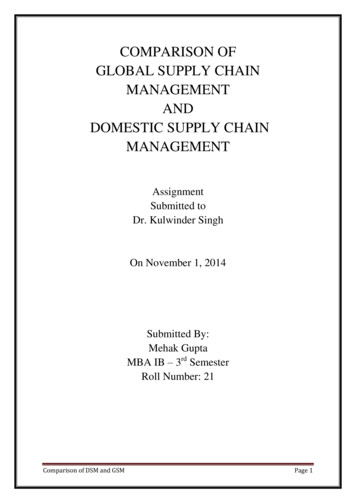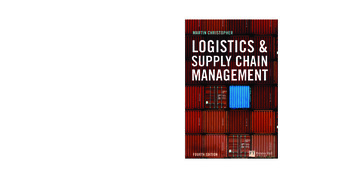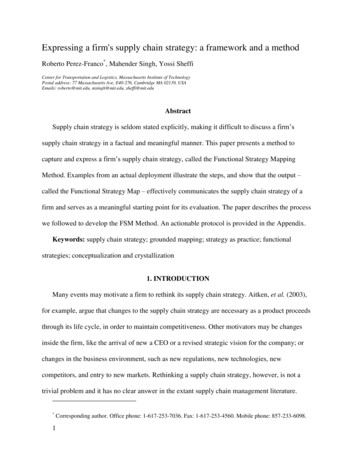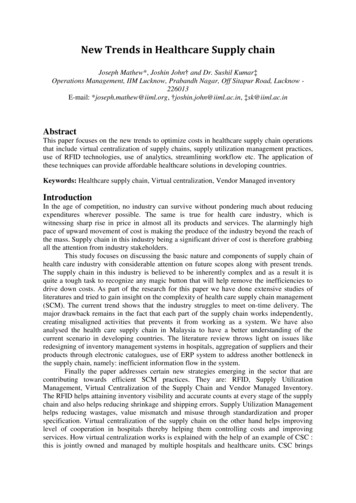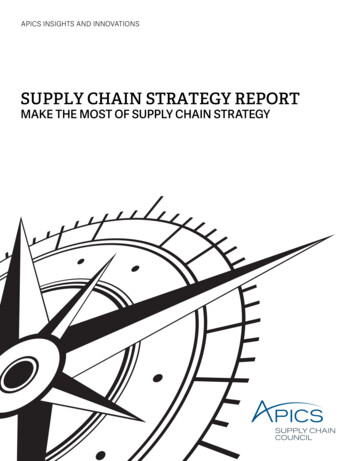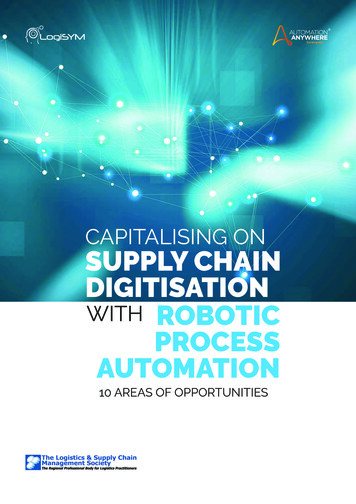
Transcription
Go be great.CAPITALISING ONSUPPLY CHAINDIGITISATIONWITH ROBOTICPROCESSAUTOMATION10 AREAS OF OPPORTUNITIES
This report was prepared by LogiSYM. LogiSYM represents the voice of logistics andsupply chain professionals in the region.July 20202
A digital workforce weavestogether disconnectedautomation tools – RoboticProcess Automation (RPA),AI, and machine learning – tothink, act and analyse the waya human worker would, andwork alongside humans. RPAas it is also referred to, has thecapability to transform supplychain management. RPA canautomate critical yet repetitiveprocesses, driving increasedefficiency, error reductionand faster throughput. Foran industry that increasinglyrequires higher logistics pipelinevelocity without sacrificingaccuracy and at lower costs,RPA is a natural choice forhigh performing supply chainorganisations3
Gartner estimates that by the end of In a nutshell, RPA helps businesses execute2022, 85% of enterprises will have someform of RPA implemented in their businessand Forrester calculates the RPA marketwill exceed a 50% CAGR by 2023, going fromroughly 500 million to 2.8 billion.core processes faster and with fewerresources. It does this by using a digitalworkforce to perform redundant and manualintensive tasks, so humans don’t have to. Thisreduces costs, errors, and inefficiencies.Organizations that have successfullyimplemented RPA initiatives report costsavings of up to 80% and time savings of upto a staggering 40%.Digital workforce is one of the obvious stepsin developing digital supply chain capabilitiesand this can be done in a number of areas.This article explores 10 possible areas inwhich can help at each stage of the flow inSupply Chain Management.SUPPLY CHAIN MANAGEMENTPROCESS FLOW DIAGRAMMaterial FlowVendorSourcingInboundStorage /TransportationOperationsOutboundStorage tion FlowMoney Flow4
1PROCUREMENTRPA can automate the uploading of reporting and contract data for transactions from contracts into Transportation Management Systems (TMS) or Enterprise ResourcePlanning (ERP) systems with greater speed and accuracy.Procurement can also have RPA do dynamic searches ofwebsites to source or conduct market research for futurebuys and tenders.2PURCHASE ORDERMANAGEMENTPurchase order management requires a thoroughreview process but having to manually review every ordercan be labour-intensive, error-prone and cause processbottlenecks.With RPA, purchase orders can be processed through automated criteria such as pricing, quantity, and regularity ofpurchase. When an approval matches optimization criteria,it gets sent through for processing with notifications to runthe remaining purchase orders that do not match the criteria being sent through to procurement managers for a formal review. With RPA only non-conforming orders will needto be reviewed with more mundane non-value adding processes performed by a digital workforce.5
3INVENTORYMANAGEMENTRegardless of how efficient and effective, allsupply chains carry inventory. Managing inventory to ensureoptimal volumes while tracking data along the way can beextremely complex and inaccurate demand and supply signals can cause stockouts, supply chain disruptions and inventory build-up like the ‘bullwhip effect’ - which is causedwhen forecasts yield supply chain inefficiencies. The bullwhip effect refers to increasing swings in inventory in response to shifts in customer demand as one moves furtherup the supply chain.RPA can help continuously monitor inventory, notifying youwhen levels are low and signal when new shipments needto be ordered and even perform the job function of an employee by ordering new shipments at the right time.Information is critical to the success of any supply chain andRPA can also be used to track inventory as it flows throughout the supply chain, if correct integration and tools areused. Manually tracking thousands or millions of items istime-consuming and prone to error. RPA can automate thisprocess by deploying a digital workforce to track inventoryas it flows from each stage of your integrated supply chain.Within your distribution centre, RPA can perform a similarfunction and make inventory management easier by tracking inventory from the time it enters and exits the facility.6
4CONTRACTREVIEWTodaymany companies spend countless hoursreviewing contracts to track and review amendments tooriginal documents. This activity in not necessarily confinedto the supply chain function but also extends to the legaland finance functions. Much of this can be overcome byadopting RPA functionality during this crucial but oftenmundane activity.5FREIGHTMANAGEMENTFreightmanagement is driven by time-critical,manual tasks. RPA brings efficiency to these taskswhile saving time and reducing errors. By automaticallyprocessing requisitions transactions using RPA (from ordersreceived from disparate systems or multiple formats fromcustomers) the effort required can be significantly reduced.RPA bots can be further programmed to deliver on-demandreporting and tracking. This will improve the ability for dataanalytics to be used to improve operations and provide anefficient and scalable freight management workflow.7
Another area where RPA is coming to the fore is incommunication. A large part of any supply chain is maintainingproper communication with suppliers, manufacturers,transportation service agencies, and customers. Eventhough concise and effective communication is such acritical part of supply chains, it is often the one that has amajor need for improvement.To ensure proper collaboration email communication can beset up with RPA. When shipments have been successfullydelivered, when they are stuck midway or delayed, andwhen they need to be cancelled.Effective communication between all parties involvedneeds to be ensured such that the customer gets asmooth experience. RPA can be used to automate thiscommunication process by triggering emails and textmessages when a specific event occurs.RPA can enhance other aspects of freight management,such as route optimization, freight accounting, and freightclaim management.8
6RETURNS &REFUNDSPROCESSINGProcessingreturns and refunds is both a high-volume and high-value business. With the tremendousgrowth in e-commerce, returns and refunds processing isset to grow tremendously and businesses that rely whollyon human intervention in their processing workflows will bequickly overwhelmed.Fortunately, refunds and returns processing are the perfectapplication for RPA. By using rules-based task automation,RPA can reduce the need for human intervention in mostcases, freeing up labour to focus on processing that reliessolely on human decisions. By reducing human interventionand automating processing, RPA accelerates resolution andreduces the risk of errors.7INVOICEMANAGEMENTManaginginvoices is vital to the success of everylogistics and supply chain business and many organisationshave dedicated backroom processing centres that handlethese tasks manually. Manually tracking and enteringinvoice data is a labour-intensive yet mission-criticalprocess, making it perfect for automation.RPA can make it easier to process invoice documents fromvendors and suppliers with less chance of error. RPA speedsup tasks such as extracting information from invoices andvalidating and verifying information, so you can free uplabour to perform higher value-added work whilst ensuringinvoices are accurately handled.8PRICE LOOKUP& COMPARISONCostsreduction of sourced materials is one way todrive down costs but manually conducting price lookupson multiple options for hundreds of products can proveuntenable very quickly.RPA can routinely search for pricing data on specifiedmaterials and structure this data in a way that makesconducting comparisons easier. This translates to gettingbetter prices more efficient – and accurate.9
9ERP INTEGRATION& COMMUNICATIONHandlingdata entry and migration is oftencumbersome, repetitive, and prone to error. With RPA, theseprocesses can be handled automatically and quickly, frominvoice data entry to data validation and monitoring. RPA canenhance ERP utilities by increasing information accuracyand reducing costs related to manual data entry.10ORDER-TO-CASHCYCLEThethree essentials that must flow effectively in anysupply chain is the product flow – either forward or reverse,the information flow and cash flow. With the latter, the entireorder to cash process can be automated with RPA.From the moment the raw material order is placed to thetime the customer books or places the order to the momentthey are engaged in the process of making payments RPA isable to help with the emails queries. This is especially usefulfor companies in e-fulfilment as the throughput in thesefacilities often number in the thousands of transactions perhour or day.10
RPA INSUPPLY CHAINMANAGEMENTRobotic Process Automation is still in its infancy in supply chain operations,however, organizations have accelerated towards including RPA in their supplychains to make them lean and efficient. MAERSK the integrated shippingcompany, for example, has implemented RPA to achieve significant ROI.Today, an intelligent digital workforce with machine learning and cognitiveabilities have led us to make RPA systems resemble humans to an extent.RPA can be used to predict outcomes and support complex decision making,thereby, helping employees with more than just robotic tasks.11
CHALLENGES IN RPAIMPLEMENTATIONFOR SUPPLY CHAINSAccording to Deloitte, there are still many challenges organizations face whenthey begin to strategise RPA or go at it for the first time.Here are the top 5 challenges the report highlights –1Process Standardizationonly learn once and that they need to be taught perfectlessons for them to perform later. Thanks to ArtificialIntelligence and Machine Learning, solution flexibilityComplex processes lead to complexity in the robot. Atcan now be added to all stages of automation, thoughall stages of the RPA journey, organizations face processagility is perceived as a challenge.standardization as a critical challenge. Complexity inprocesses hike the costs of implementing RPA whileincreasing operating costs and business disruption.Organizations, unfortunately, realize that where properdocumentation exists, even in those places, theprocesses are not always well understood.4Stakeholder ExpectationsStakeholders have now started warming up to RPA, butit is a significant challenge to move RPA in Supply Chain2up the priority ladder, and make sure it does not amountto complete disruption.IT SupportThe support and consultancy of an IT organization arevital while strategizing RPA in the supply chain. It isessential and advisable to include an IT organizationthroughout the RPA implementation process.35Employee EngagementOrganizations that have succeeded in scaling RPAhad first engaged their employees and built buy-into change processes org-wide. Though things varyacross organizations, there is a need for enterprises toThe Flexibility of Solutiontake steps so that employees accept RPA with minimalRPA, at the outset, used to be considered a stagnantresistance.automation process. It carried a notion that robots will12
THE RPA REALITYRPA has emerged as a cost-effective way for supply chain and logisticsoperations to optimize their processes whilst at the same time cutting costs.Benefits ofBenefits ofOptimisingRPAEMPLOYEESOPERATIONS Increase customersatisfaction bystreamlining service Improve service andproduct quality byminimizing humanerror Deliver products andservices to marketfaster Eliminate repetitive,manual tasks Reduce costs up to80% Increased jobsatisfaction byfocussing on highervalue-add activities. Improve speed andefficiency up to 40% Providing highdemand skills andcapabilities Provide moreinnovative productsand services Scale robots up ordown quickly atmarginal to no cost Improve governanceand compliance Gain access toprocess reportingand analytics to makeintelligent businessdecisionsOrchestrating these pieces together is an understandableThere is no one-size-fits-all model for digital transformation.challenge but strategising and planning each part of the RPAYour organisation will need an IT partner who can tailorimplementation process and integrating a transformationRPA implementation to your needs, being mindful of themindset into everyone in the organization is crucial.operating scenario and the organisational end goals. RPAin comparison to traditional automation not only frees upIf you are looking to partner with a digital transformationlabour to perform higher-value activities but revampsfacilitator organization, enterprises need to take an end-everything an organisation was built upon. New issues mayto-end approach with RPA in Supply Chain implementationarise in the service delivery process, and entire operationsto achieve full benefits and realize the anticipated ROI andmay need to be reworked, all for better productivity andfinding the correct partner to work alongside and with themefficiency that will pay dividends at the end of the day!on this journey is crucial.13
Go be great.Automation Anywhere is a global leader in RoboticProcess Automation (RPA), empowering customers toautomate end-to-end business processes with softwarebots – digital workers that perform repetitive and manualtasks, resulting in dramatic productivity gains, optimizedcustomer experience and more engaged employees. Thecompany offers the world’s only web-based and cloudnative intelligent automation platform combining RPA,artificial intelligence, machine learning, and analyticsright out of the box, to help organizations rapidly startand scale their process automation journey. Its Bot Storeis the world’s first and largest marketplace with morethan 850 pre-built, intelligent automation solutions. Withoffices in more than 40 countries and a global network of1,900 partners, Automation Anywhere has deployed over2.1 million bots to support some of the world’s largestenterprises across all industries. For additional information,visit www.automationanywhere.com.LogiSYM is the collaborative platform of the logistics &supply chain management society. LogiSYM engagespractitioners and service providers through a range ofmediums and Platforms across the Middle East and AsiaPacific region. Two of the largest circulation supply chainpublications globally Press-releases Webinar Sponsorship Online Advertising Industry led symposiums Surveys & survey analysis Advertisements in two of the largest circulationsupply chain publications Online articles Content syndication White label reports and thought leadershiparticles Electronic Direct Mail (EDM) Social Media - LinkedIn, Facebook, Youtube14
automation process. It carried a notion that robots will Stakeholders have now started warming up to RPA, but ô á a á v ica ô c a e ve ô Ĝe RPA SăÇÇ Ĥ C a up the priority ladder, and make sure it does not amount to co



